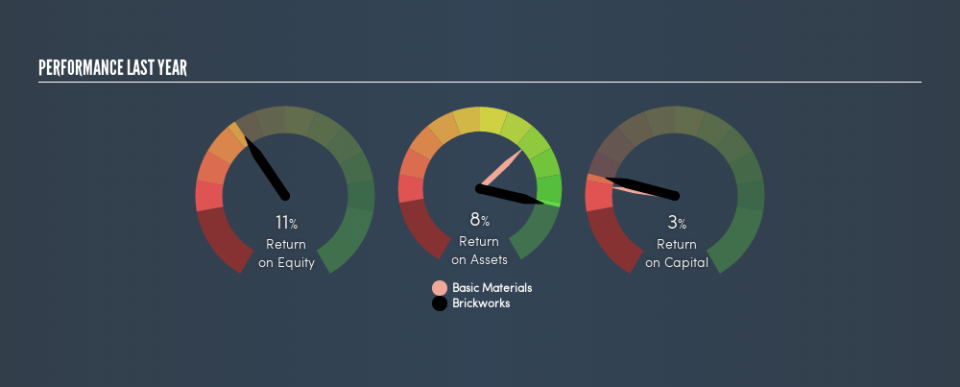Should Brickworks Limited’s (ASX:BKW) Weak Investment Returns Worry You?

Want to participate in a short research study? Help shape the future of investing tools and you could win a $250 gift card!
Today we'll look at Brickworks Limited (ASX:BKW) and reflect on its potential as an investment. In particular, we'll consider its Return On Capital Employed (ROCE), as that can give us insight into how profitably the company is able to employ capital in its business.
First of all, we'll work out how to calculate ROCE. Next, we'll compare it to others in its industry. Last but not least, we'll look at what impact its current liabilities have on its ROCE.
What is Return On Capital Employed (ROCE)?
ROCE measures the 'return' (pre-tax profit) a company generates from capital employed in its business. All else being equal, a better business will have a higher ROCE. Ultimately, it is a useful but imperfect metric. Renowned investment researcher Michael Mauboussin has suggested that a high ROCE can indicate that 'one dollar invested in the company generates value of more than one dollar'.
How Do You Calculate Return On Capital Employed?
Analysts use this formula to calculate return on capital employed:
Return on Capital Employed = Earnings Before Interest and Tax (EBIT) ÷ (Total Assets - Current Liabilities)
Or for Brickworks:
0.029 = AU$76m ÷ (AU$3.0b - AU$411m) (Based on the trailing twelve months to January 2019.)
Therefore, Brickworks has an ROCE of 2.9%.
Check out our latest analysis for Brickworks
Does Brickworks Have A Good ROCE?
ROCE is commonly used for comparing the performance of similar businesses. We can see Brickworks's ROCE is meaningfully below the Basic Materials industry average of 11%. This could be seen as a negative, as it suggests some competitors may be employing their capital more efficiently. Putting aside Brickworks's performance relative to its industry, its ROCE in absolute terms is poor - considering the risk of owning stocks compared to government bonds. There are potentially more appealing investments elsewhere.
In our analysis, Brickworks's ROCE appears to be 2.9%, compared to 3 years ago, when its ROCE was 2.1%. This makes us think the business might be improving.
It is important to remember that ROCE shows past performance, and is not necessarily predictive. Companies in cyclical industries can be difficult to understand using ROCE, as returns typically look high during boom times, and low during busts. This is because ROCE only looks at one year, instead of considering returns across a whole cycle. Future performance is what matters, and you can see analyst predictions in our free report on analyst forecasts for the company.
Brickworks's Current Liabilities And Their Impact On Its ROCE
Current liabilities include invoices, such as supplier payments, short-term debt, or a tax bill, that need to be paid within 12 months. The ROCE equation subtracts current liabilities from capital employed, so a company with a lot of current liabilities appears to have less capital employed, and a higher ROCE than otherwise. To counteract this, we check if a company has high current liabilities, relative to its total assets.
Brickworks has total assets of AU$3.0b and current liabilities of AU$411m. As a result, its current liabilities are equal to approximately 14% of its total assets. This is not a high level of current liabilities, which would not boost the ROCE by much.
Our Take On Brickworks's ROCE
While that is good to see, Brickworks has a low ROCE and does not look attractive in this analysis. You might be able to find a better investment than Brickworks. If you want a selection of possible winners, check out this free list of interesting companies that trade on a P/E below 20 (but have proven they can grow earnings).
If you like to buy stocks alongside management, then you might just love this free list of companies. (Hint: insiders have been buying them).
We aim to bring you long-term focused research analysis driven by fundamental data. Note that our analysis may not factor in the latest price-sensitive company announcements or qualitative material.
If you spot an error that warrants correction, please contact the editor at editorial-team@simplywallst.com. This article by Simply Wall St is general in nature. It does not constitute a recommendation to buy or sell any stock, and does not take account of your objectives, or your financial situation. Simply Wall St has no position in the stocks mentioned. Thank you for reading.

 Yahoo Finance
Yahoo Finance 
